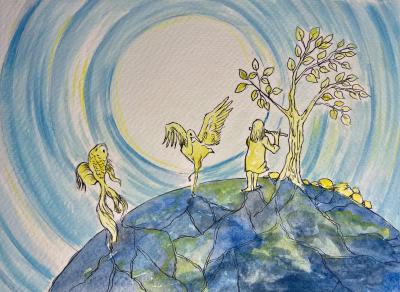An Ode To Imagination


What is unique about human beings? That was the question that followed me. Other philosophers have supposed that our form of consciousness is unique among the animals, or our symbol-making ability. But I want to propose something else that may be unique to our species, and that is our ability to imagine what does not yet exist, and then to create it. As far as we know, no other species has this capacity, with which we have made violins, iPhones, Hubble telescope, nuclear weapons, space travel. I mean, we know that beavers, who must keep trimming their ever growing teeth, gnaw down trees to build dams – but they don’t seem to be building dams intended to light up Las Vegas. I want to propose that everything human beings have intentionally made, every modification to our "natural habitat", was born first in imagination. For better and worse. The human imagination may be our greatest unacknowledged and underutilized innate capacity.
But in our era of ever-present media, our innate capacities for imagination may be suppressed by the constant bombardment of ready-made images from advertising, entertainment, news media, and political points of view. We are living amidst the greatest colonization of imagination ever known. In her poem “Rant,” Diane di Prima recognizes the catastrophic consequences of a battle for control of the human imagination: "the war that matters is the war against the imagination / all other wars are subsumed in it. / the ultimate famine is the starvation / of the imagination."
Our human capacities for imagination can still be cultivated, though, even now, when imaginative acts may be essential for the well-being of the Earth community.
For today, I want to connect the human capacity for imagination with the capacity for perception of an animate world. All of our ancestors, presumably, lived in a world brimming with participants, a world of companions, where birds might be regarded as messengers, where stone could be imbued with indwelling spirits, where snakes sometimes spoke or offered guidance. All of our ancestors, presumably, inhabited an animate world – some of our ancestors might still engage with a world full of intelligent Others.
Many contemporary people understand that other-than-human beings are intelligent and saturated in subjectivity, but the understanding might be more intellectual than experienced, because the dead universe worldview – with which most Westerners are deeply, though perhaps unconsciously, rooted – shapes perception. Those who seldom regard the Others as alive and intelligent may reflexively exclude from our embodied awareness any hint that suggests otherwise – even if we long for wildly intimate, reciprocal encounters and interactions.
What arises in your imagination if you contemplate the possibility that the ordinary "objects" accompanying our days might have life and longings of their own? That the walls of the house were once part of a living forest; that the water through the tap has a wild origin? If our everyday awareness included felt-recognition of the noble longings of rivers, meadows, or corn, might we question, or even re-envision, our human ventures?
Geneen Marie Haugen, PhD, grew up as a free-range wildish kid with a run amok imagination. She is a guide with the Animas Valley Institute, and is on the faculty of the Esalen Institute, Schumacher College, and the Fox Institute for Creation Spirituality. Excerpt above from this article.
SEED QUESTIONS FOR REFLECTION: How do you relate to the notion of colonization of imagination and the need to cultivate our human capacity for imagination? Can you share a personal story of a time you became aware of a world full of intelligent ‘Others’? What helps you develop embodied awareness of ‘Others’ as alive and intelligent?
Add Your Reflection
19 Past Reflections

On Sep 1, 2023 Christine wrote :
Post Your Reply

On Aug 29, 2023 Karuna wrote :
Post Your Reply

On Aug 29, 2023 Anil Pandit wrote :
Post Your Reply

On Aug 29, 2023 anand damani wrote :
At the moment enrich the planet instead of depleting the same.
Post Your Reply

On Aug 29, 2023 Sandip Sheta wrote :
Post Your Reply

On Aug 29, 2023 Jagannatha Das wrote :
2 replies: David, Stream | Post Your Reply

On Aug 24, 2023 Michael Maxwell Steer wrote :
Post Your Reply

On Aug 24, 2023 Jagdish P Dave wrote :
1 reply: Stream | Post Your Reply

On Aug 24, 2023 David Doane wrote :
1 reply: Stream | Post Your Reply

On Aug 24, 2023 stream wrote :
All beings are safe, well nourished, well housed and happy. I forgive myself and everything and everyone else.
And I am another you and you are another me. Colonization was a construct of the warrior cult.
2 replies: Pat, Stream | Post Your Reply

On Aug 23, 2023 Paul wrote :
I value deep silence—with patience, there are many levels of awareness without words, listen with your eyes, hear with your heart and let your imagination free.
I value community—we aren’t alone, we are part of a whole, everything works better when we realize our purpose here is to serve each other.